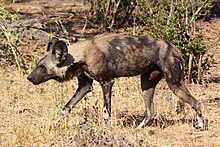Cape wild dog
| Cape wild dog | |
|---|---|

| |
| A Cape wild dog at Okavango Delta, Botswana. | |
| Scientific classification | |
| Domain: | Eukaryota |
| Kingdom: | Animalia |
| Phylum: | Chordata |
| Class: | Mammalia |
| Order: | Carnivora |
| Family: | Canidae |
| Genus: | Lycaon |
| Species: | |
| Subspecies: | L. p. pictus
|
| Trinomial name | |
| Lycaon pictus pictus Temminck, 1820
| |
The Cape wild dog (Lycaon pictus pictus), also known as the South African wild dog, Cape hunting dog, or the painted wolf, is the nominate subspecies of African wild dog native to Southern Africa.
Characteristics
The Cape wild dog is the largest subspecies, weighing 20–25 kg (44–55 lb).[2] It is much more colourful than the East African subspecies,[2] though even within this single subspecies there are geographic variations in coat colour: specimens inhabiting the Cape are characterised by the large amount of orange-yellow fur overlapping the black, the partially yellow backs of the ears, the mostly yellow underparts and a number of whitish hairs on the throat mane. Those in Mozambique are distinguished by the almost equal development of yellow and black on both the upper and underparts of the body, as well as having less white fur than the Cape form.[3]
Habitat and distribution
Southern Africa contains numerous viable wild dog populations, one of which encompasses northern Botswana, northeastern Namibia and western Zimbabwe. In South Africa, around 400 individuals occur in the country's Kruger National Park. Zambia holds two large populations, one in Kafue National Park and another in the Luangwa Valley. However, the wild dog is rare in Malawi and probably extinct in Angola and Mozambique.[4]
In folklore
The Cape wild dog plays a prominent role in the mythology of Southern Africa's San people. In one story, the wild dog is indirectly linked to the origin of death, as the hare is cursed by the moon to be forever hunted by wild dogs after the hare rebuffs the moon's promise to allow all living things to be reborn after death. Another story has the god Cagn taking revenge on the other gods by sending a group of men transformed into African wild dogs to attack them, though who won the battle is never revealed. The San of Botswana see the Cape wild dog as the ultimate hunter and traditionally believe that shamans and medicine men can transform themselves into Cape wild dogs. Some San hunters will smear Cape wild dog bodily fluids on their feet before a hunt, believing that doing so will gift them with the animal's boldness and agility. Nevertheless, the species does not figure prominently in San rock art, with the only notable example being a frieze in Mount Erongo showing a pack hunting two antelopes.[5]
Gallery
-
play fighting after feeding
References
- ^ McNutt; et al. (2008). "Lycaon pictus". IUCN Red List of Threatened Species. 2008. Retrieved 6 May 2008.
{{cite journal}}: Invalid|ref=harv(help) Database entry includes justification for why this species is endangered - ^ a b Estes, R. (1992). The behavior guide to African mammals: including hoofed mammals, carnivores, primates. University of California Press. pp. 410-419. ISBN 0-520-08085-8.
- ^ Bryden, H. A. (1936), Wild Life in South Africa, George G. Harrap & Company Ltd., pp. 19-20
- ^ Fanshawe, J. H., Ginsberg, J. R., Sillero-Zubiri, C. & Woodroffe, R., eds. 1997. The Status & Distribution of Remaining Wild Dog Populations. In Rosie Woodroffe, Joshua Ginsberg & David MacDonald, eds., Status Survey and Conservation Plan: The African Wild Dog: 11-56. IUCN/SSC Canid Specialist Group.
- ^ De la Harpe R. & De la Harpe, P. (2010). In search of the African wild dog: the right to survive. Sunbird. p. 41. ISBN 1-919938-11-7




